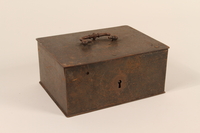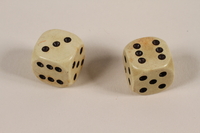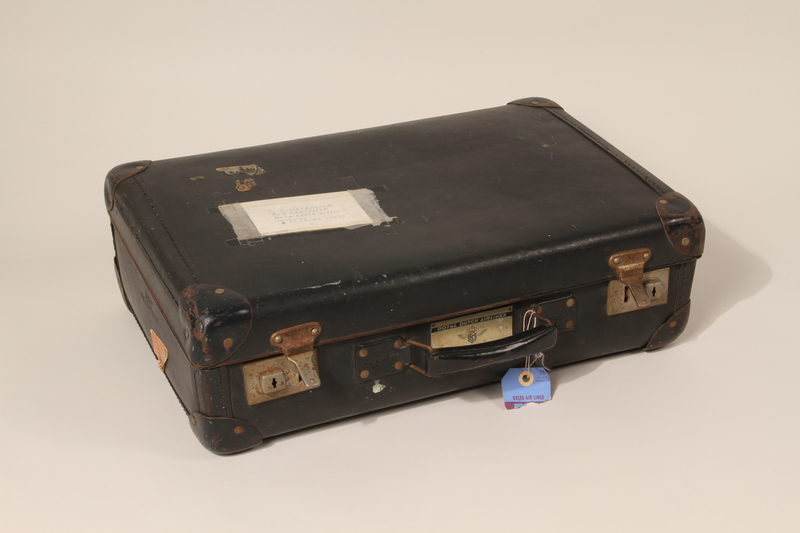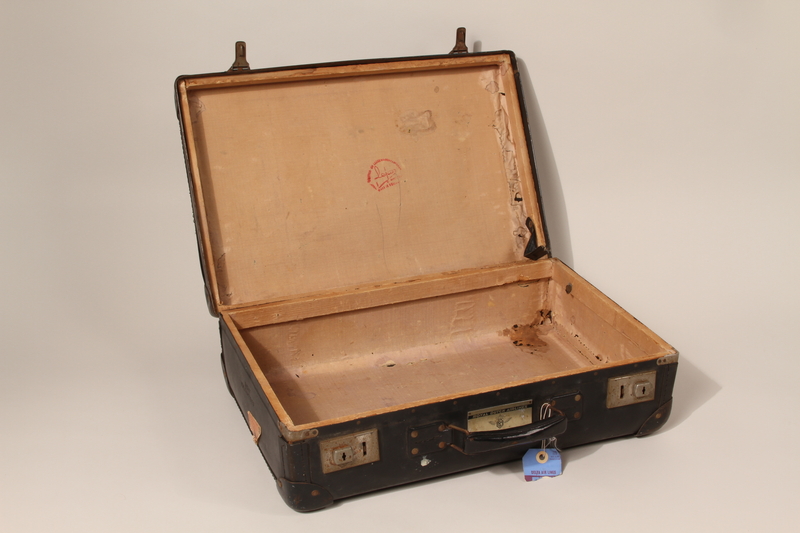Overview
- Brief Narrative
- Small black suitcase used by 8 year old Elisabeth Blind and her mother, Schoontje Visser, when they lived in hiding in Amsterdam from approximately 1941-1945. The Netherlands was occupied by Germany on May 10, 1940. Schoontje obtained false identification papers and, with the help of Willem Schalbroeck, a resistance member, she and Elisabeth hid in various locations. The suitcase was always packed in case they had to go to a cellar during bombing raids. In May 1945, Amsterdam was liberated by Canadian forces. Schoontje’s entire family was killed in Auschwitz death camp.
- Date
-
use:
approximately 1941-1945
- Geography
-
use:
in hiding;
Amsterdam (Netherlands)
- Credit Line
- United States Holocaust Memorial Museum Collection, Gift of Elisabeth and Maurits Munichman
- Markings
- hinges, back exterior, engraved : U.K. PAT. No 427897 / AND OTHERS
base, left and right sides, embossed : ECHT / VULCANFIBER - Signature
- 2004.301.2
- Contributor
-
Subject:
Elisabeth Munichman
Subject: Maurits Munichman
Subject: Schoontje Schalbroeck
- Biography
-
Elisabeth Blind was born in Amsterdam, Netherlands, in 1932, to Cornelius Blind and Schoontje Visser. Schoontje was born on December 2, 1909, to Benjamin Visser, born on August 28, 1875, in Amsterdam, and Henriette Brilleslyper, born on June 21, 1880, in Friedland. Schoontje had six siblings: Levi, born on June 29, 1907, Jacob, born on November 16, 1913, Sara, Betsy, Max, and Josef, who was born on December 2, 1909 and died before the war. Cornelius and Schoontje divorced in the late 1930s.
Germany occupied the Netherlands on May 10, 1940. Schoontje obtained false identity papers for herself and Elisabeth and they went into hiding. With the help of the Dutch underground, in particular Willem Schalbroeck, they were moved from place to place. They kept a small suitcase that was always packed to take to the cellar during bombing raids.
At one point, Elisabeth and Schoontje hid with the Mooi family. They also lived on Burmenstraat which had bunkers at the end of the street where the Germans held Jews until trucks came to take them away. One day, Elisabeth was sent to get milk. As she walked to the store, a Dutch neighbor suspected of being a German sympathizer and who often listened to German music, followed her and asked the owner why he let in a Jew. The owner knew Elisabeth was Jewish, but told the woman that she was not. The woman dragged Elisabeth out by the hair. Elisabeth often searched through rubbish to fill a wagon with potato peels, and then would walk for hours in her wooden shoes to trade the peels to farmers for food and milk.
Schoontje’s sister, Betsy Swaab, her husband Sam, and children, Jacob and Henriette, lived nearby. Elisabeth would bike to her house to get some sugar. In spring 1943, she saw a crowd watching Germans collect Jews for deportation. Elisabeth snuck near and watched as her Aunt Betsy and her thirteen year old cousin, Henriette, were arrested. Henriette carried a pillowcase with her belongings over her shoulder. She hurried home to tell Schoontje. Her aunt’s family was sent to Westerbork transit camp.
Elisabeth’s maternal grandparents, Benjamin and Henriette Brilleslyper, were deported separately to Westerbork transit camp. Benjamin was ill and sent to the hospital ward. Henriette wrote to Schoontje, thanking her for packages and asking her to send beet pills for the water, but not soap, as they had enough. Willem Schalbroeck, the resistance member, went to Westerbork to try and obtain their release. He brought false identity papers and food, but they were no longer there. Roza Koster, a prisoner and a friend of Henriette’s, wrote Schoontje, and told her that the couple had been deported to Auschwitz concentration camp together by ambulance on March 14, 1944. Many of Henriette’s belongings were left behind and Roza was going to try and send them to Schoontje.
Amsterdam was liberated by Canadian forces in Amsterdam in May 1945. Next door to their hiding place was a bicycle shop; Elisabeth saw 10 family members emerge that she never knew were hiding there. Food was extremely scarce and a malnourished Elisabeth, with the assistance of a Jewish organization, was sent to live with a Jewish family in Switzerland to recover. After 3 months, she was sent to Denmark and then returned to her mother in Amsterdam.
Most of Elisabeth’s maternal relatives were killed in Auschwitz: Levi Visser died on September 30, 1942; Esther Swaab Franshman and 5 month old cousin Mozes died on November 23, 1942; Jacob and Mariane Rood Visser were first sent to Vught, then to Auschwitz where Mariane died on September 24, 1943, and Jacob on January 8, 1944; her grandparents, Henriette and Benjamin, died on March 26, 1944. A brother, Max, survived in hiding.
Maurits Munichman was born on November 26, 1931, in Amsterdam, Netherlands, to a non-Jewish father, Herman, a furrier. His mother, Hanna Santilhano, had a British father, eight or nine siblings, and held a British as well as a Dutch passport.
Germany occupied the Netherlands on May 10, 1940. Herman, a member of the Dutch underground, stole from the Germans, then sold the stolen items back to them. He used the money to buy false identification papers for hidden Jews. He was arrested, but refused to tell the police what he had done and who his accomplices were, insisting that he worked alone. The Germans tortured him by hanging him in a water filled cabinet, but he did not confess.
In 1941 or 1942, Maurits was sent to live on a farm in Austerlitz. He would alternate between there and another location from 1943-1945. Herman paid the farmer to hide Maurits, but they treated Maurits like family and told people that he was one of their children and had been in a sanatorium with tuberculosis. Maurits had blond hair and blue eyes and passed as a non-Jew. Hanna, who stayed in Amsterdam, was sterilized by the Germans because she was Jewish and her passport was stamped with a red “J”.
In the spring of 1945, Canadian forces liberated Amsterdam. Maurits was sent to a different farm for a few months, probably because food was available there, before he returned to his parents in Amsterdam. Some of Maurits’ maternal aunts and uncles, including Sally Santilhano, were deported to Bergen-Belsen concentration camp, but survived because of their British passports. An uncle and cousin were killed in France; one aunt survived with help from the French underground and another uncle survived in Switzerland. Herman, due to lasting effects from his torture, died in 1950. In 1953, with help from the Hebrew Immigrant Aid Society, Maurits and his first wife emigrated to the United States. He later met and married Elisabeth Blind, who had survived the war as a hidden child in Amsterdam.
Schoontje Visser was born on December 2, 1909, to Benjamin Visser, born on August 28, 1875, in Amsterdam, and Henriette Brilleslyper, born on June 21, 1880, in Friedland. She had six siblings: Levi, born on June 29, 1907, Jacob, born on November 16, 1913, Sara, Max, Betsy, and Josef, who died before the war. Schoontje married Cornelius Blind and they had a daughter, Elisabeth, born in 1932, in Amsterdam. The couple divorced in the late 1930s.
Germany occupied the Netherlands on May 10, 1940. Schoontje had false identity papers for herself and Elisabeth and they went into hiding. With the help of the Dutch underground and a resistance member, Willem Schalbroeck, they were moved from place to place. They had a small suitcase that was always packed to take to the cellar during bombing raids.
Elisabeth and Schoontje hid with the Mooi family, who lived near a collection center where Jews were brought prior to deportation. One day, Elisabeth was sent to get milk. As she walked to the store, a Dutch neighbor who often listened to German music and was considered a German sympathizer, followed her and asked the owner why he let a Jew in. The owner knew Elisabeth was Jewish, but told the woman that she was not. The woman dragged Elisabeth out by the hair. Elisabeth often filled a wagon with potato peels, and wearing wooden shoes, walked for hours to trade them with farmers for food and milk.
Schoontje’s sister, Betsy Swaab, and her husband Sam, and two children, Jacob and Henriette, lived nearby. In spring 1943, Elisabeth biked to her house to get some sugar. She saw a crowd watching Germans collect Jews for deportation. Elisabeth snuck close and watched as her Aunt Betsy and her 13 year old cousin, Henriette, were arrested. Henriette carried a pillowcase with her belongings over her shoulder. She hurried home to tell Schoontje. Her aunt’s family was sent to Westerbork transit camp. Betsy wrote Schoontje a postcard and threw it out the train window on the transport and someone sent it to Schoontje. Betsy wrote that she was never going to see Schoontje again. Schoontje sent packages to Betsy and received short letters from Betsy in return. In one postcard, she told Schoontje to send no more packages as she was being transported to a different camp. Schoontje’s brother, Jacob, and his wife Mariane, were sent to Westerbork and wrote Schoontje to thank her for her packages. They were transferred to Vught concentration camp in Holland.
Benjamin and Henriette were deported separately to Westerbork transit camp. Benjamin was ill and sent to the hospital ward. Henriette wrote to Schoontje, thanking her for packages and asking her to send beet pills for the water, but not soap, as they had enough. Willem Schalbroeck, the resistance member, went to Westerbork to try and obtain their release. He brought false identity papers and food but it was too late. Roza Koster, a prisoner at Westerbork and a friend of Henriette, wrote Elisabeth and Schoontje, and told them that the couple had been deported to Auschwitz concentration camp. They were transported together by ambulance to Auschwitz on March 14, 1944. Many of Henriette’s belongings were left behind and Roza was going to try and send them to Schoontje.
Schoontje and Elisabeth were liberated by Canadian forces in Amsterdam in May 1945. They were surprised to learn that a family of 10 had lived in hiding in the bicycle shop next to their hiding place for the duration of the war. Elisabeth was malnourished and, with the assistance of a Jewish organization, was sent to live with a Jewish family in Switzerland to recover. After 3 months, she was sent to Denmark, and then returned to Amsterdam, and reunited with Schoontje.
Schoontje lost most of her family in Auschwitz: : Levi Visser died on September 30, 1942; Esther Swaab Franshman and 5 month old cousin Mozes died on November 23, 1942; Jacob and Mariane Rood Visser were first sent to Vught, then to Auschwitz where Mariane died on September 24, 1943, and Jacob on January 8, 1944; her grandparents, Henriette and Benjamin, died on March 26, 1944. A brother, Max, survived in hiding. There was no news about her sister Betsy’s husband, Sam, or their son, Jacob.
Physical Details
- Classification
-
Containers
- Category
-
Luggage
- Object Type
-
Suitcases (aat)
- Physical Description
- Small, rectangular, black Vulcanfiber suitcase with topstitched, reinforced side edging. There are black painted, silver colored metal corner bumpers and black painted metal trim on the lid edge. The lid attaches to the base by 2 engraved hinges. On the front are 2 hasp locks and keyplates, corroded, possibly brass, a black leather covered metal handle attached by D rings, and silver colored metal edge clamps visible when open. Silver colored metal feet are riveted to the back of the lid, base corners, and underside. The left and right base sides have embossed text. The interior is lined with stained, torn, light brown, patterned paper. Wood supports reinforce the lid and base edges. A black faux leather lid stay is nailed to the right lid support, but has torn off the base support. The lid interior has a red manufacturer's stamp with Dutch and German text. On the exterior lid is a handwritten white paper address label taped on and covered in plastic; on the sides are a custom sticker and a label remnant; on the base front behind the handle is an metal Dutch airlines plate with English text. A partially torn luggage tag is tied to the handle. There are marks overall of frequent use, paint is worn off, and the lid is slightly warped.
- Dimensions
- overall: Height: 6.125 inches (15.558 cm) | Width: 19.250 inches (48.895 cm) | Depth: 13.500 inches (34.29 cm)
- Materials
- overall : cellulose, wood, cloth, metal, paper, plastic, adhesive tape, ink, string, graphite
- Inscription
- lid, exterior, on white paper, handwritten, blue ink : S. ScHALBROECK / 84. B MANSFIELD. / BOCA. RATON. (WEST) / cens. VILL. / E FLORIDA 33434 [E is scratched out]
base, exterior front, metal plate, black ink : ROYAL DUTCH AIRLINES / KLM logo / KONINKLIJKE LUCHTVAART MIJ.N.V. [ROYAL AIR]
base, exterior, left side, on sticker, red and black ink : UNITED STATES / CUSTOMS SERVICE / INSPECTED / (?)GGAGE / 68
base, exterior, handle, luggage tag, front, purple ink : 0419 / 70538 / REV 5-75 / Printed in U.S.A.
base, exterior, handle, luggage tag, reverse, red ink : F (?)
lid, interior, stamped, red ink : (?) EN LEDERWARENFABRIKEN / Lejan / AMSTERDAM / MADE IN HOLLAND [LEATHER FACTORIES]
Rights & Restrictions
- Conditions on Access
- No restrictions on access
- Conditions on Use
- No restrictions on use
Keywords & Subjects
- Topical Term
- Hidden children (Holocaust)--Netherlands--Amsterdam--Biography. Holocaust, Jewish (1939-1945)--Netherlands--Amsterdam--Personal narratives, Jewish. Holocaust survivors--United States--Biography. Jewish children in the Holocaust--Netherlands--Amsterdam--Biography. Jews--Rescue--Netherlands--Biography. World War, 1939-1945--Netherlands--Personal narratives, Jewish.
Administrative Notes
- Legal Status
- Permanent Collection
- Provenance
- The suitcase was donated to the United States Holocaust Memorial Museum in 2004 by Elisabeth and Maurits Munichman.
- Funding Note
- The cataloging of this artifact has been supported by a grant from the Conference on Jewish Material Claims Against Germany.
- Record last modified:
- 2022-08-17 12:43:12
- This page:
- https://collections.ushmm.org/search/catalog/irn515151
Also in Elisabeth and Maurits Munichman family collection
The collection consists of dice, a strongbox, a suitcase, correspondence, documents, and photographs relating to the experiences of Maurits Munichman and his parents, Herman and Hanna Santilhano Munichman, and Elisabeth Blind (later Munichman) and her mother, Schoontje Visser, and their families in the Netherlands during the Holocaust.
Date: approximately 1940-approximately 1945

Strongbox and 2 skeleton keys used by a Dutch resistance member
Object
Metal box with keys used by Herman Munichman to store papers during the German occupation of the Netherlands, 1940-1945. Herman, who was not Jewish, lived in Amsterdam with his wife, Hanna, a British and Dutch citizen, and son, Maurits. A member of the Dutch underground, Herman stole from the Germans and then sold the items back to them. He was arrested and tortured, but refused to tell what he had done and insisted that he worked alone. In 1941 or 1942, Herman sent 10 year old Maurits to live in hiding. In spring 1945, Canadian forces liberated Amsterdam. Within a few month, Maurits returned to his parents in Amsterdam.

Pair of dice carried by a Dutch resistance member
Object
Pair of dice carried by Herman Munichman during the German occupation of the Netherlands, 1940-1945. Herman, who was not Jewish, lived in Amsterdam with his wife, Hanna, a British and Dutch citizen, and son, Maurits. A member of the Dutch underground, Herman stole from the Germans and then sold the items back to them. He was arrested and tortured, but refused to tell what he had done and insisted that he worked alone. In 1941 or 1942, Herman sent 10 year old Maurits to live in hiding. In spring 1945, Canadian forces liberated Amsterdam. Within a few month, Maurits returned to his parents in Amsterdam.
Elisabeth and Maurits Munichman papers
Document
The papers consist of six photographs of members of the Visser family, one photograph of a group of men and women at the Joodsche Schouwburg the day before their deportation, and letters and postcards sent from Visser family members at Vught and Westerbork concentration camps to Schoontje Visser [mother of Elisabeth Munichman].





